Numerical Simulation of the Heat Transfer and Flow Characteristics of Pulse Tube Refrigerators
Abstract
:1. Introduction
2. Governing Equations
3. Numerical Model
3.1. Geometric Model
3.2. Initial and Boundary Conditions
3.3. Solving Method
3.4. Model Validation
4. Results and Discussion
4.1. Effect of the Conical Tube on the Cooling Rate
4.2. Temperature Variation in the Pulse Tube
4.3. Variation of Velocity in the Pulse Tube
4.4. Multi-Dimensional Flow Analysis in Pulsed Tubes
4.5. Effect of the Conical Tube on the Cooling Capacity and COP
5. Conclusions
Author Contributions
Funding
Data Availability Statement
Acknowledgments
Conflicts of Interest
Nomenclature
| A0 | Maximum displacement | t | Time |
| CD | Taper pulse tube | Stress tensor | |
| CHX | Cold Heat Exchanger | Velocity | |
| COP | Coefficient of Performance | v | Viscosity |
| Ef | Fluid total energy | w | Angular frequency |
| Es | Solid total energy | WHX1 | Aftercooler |
| F | Body force | WHX2 | Hot heat exchanger |
| f | Frequency | ρf, ρ | Fluid density |
| kf, keff | Thermal conductivity | ρs | Solid density |
| P | Pressure | Φ | Porosity |
| S | Source term | ω | Vorticity |
| T | Temperature |
References
- Bian, S. Small Cryogenic Refrigerator; Mechanical Industry Press: Xi’an, China, 1983. [Google Scholar]
- Gifford, W.E.; Longsworth, R.C. Pulse tube refrigeration. J. Eng. Ind.-Trans. ASME 1964, 86, 264–270. [Google Scholar] [CrossRef]
- Longsworth, R.C. An Experimental Investigation of Pulse Tube Refrigeration Heat Pumping Rates. In Advances in Cryogenic Engineering; Springer: New York, NY, USA, 1967; pp. 608–618. [Google Scholar]
- Mikulin, E.I.; Tarasov, A.A.; Shkrebyonock, M.P. Low temperature expansion pulse tubes. Adv. Cryog. Eng. 1984, 29, 629–637. [Google Scholar]
- Radebaugh, R.; Zimmerman, J.; Smith, D.R. A comparison of three types of pulse tube refrigerators: New methods for reaching 60 K. Adv. Cryog. Eng. 1986, 31, 779–789. [Google Scholar]
- Kanao, K.; Watanabe, N.; Kanazawa, Y. A miniature pulse tube refrigerator for temperature below 100 K. Cryogenics 1994, 34, 167–170. [Google Scholar] [CrossRef]
- Cha, J.S.; Ghiaasiaan, S.M.; Desai, P.V. Multi-dimensional flow effects in pulse tube refrigerators. Cryogenics 2006, 46, 658–665. [Google Scholar] [CrossRef]
- Pang, X.; Dai, W.; Wang, X.; Ma, S. CFD investigation on the characteristics of annular pulse tube. Int. J. Refrig. 2020, 114, 181–188. [Google Scholar] [CrossRef]
- Dai, Q.; Chen, Y.; Yang, L. CFD investigation on characteristics of oscillating flow and heat transfer in 3D pulse tube. Int. J. Heat Mass Transf. 2015, 84, 401–408. [Google Scholar] [CrossRef]
- Yan, C.; Zhang, Y.; Qiu, J.; Chen, Y.; Wang, X.; Dai, W.; Ma, M.; Li, H.; Luo, E. Numerical and experimental study of partly tapered pulse tube in a pulse tube cryocooler—ScienceDirect. Int. J. Refrig. 2020, 120, 474–480. [Google Scholar] [CrossRef]
- Abolghasemi, M.A.; Stone, R.; Dadd, M.; Bailey, P.; Liang, K. Minimising flow losses within the pulse tube of a Stirling pulse tube cryocooler. IOP Conf. Ser. Mater. Sci. Eng. 2019, 502, 012044. [Google Scholar] [CrossRef]
- Ashwin, T.R.; Narasimham, G.; Jacob, S. CFD analysis of high frequency miniature pulse tube refrigerators for space applications with thermal non-equilibrium model. Appl. Therm. Eng. 2010, 30, 152–166. [Google Scholar] [CrossRef]
- He, Y.; Gao, C.; Xu, M.; Chen, Z.; Tao, W. Numerical simulation of convergent and divergent tapered pulse tube cryocoolers and experimental verification. Cryogenics 2001, 41, 699–704. [Google Scholar]
- Yang, L.W. Experimental research of high frequency tapered pulse tube cooler. Cryogenics 2009, 49, 738–741. [Google Scholar] [CrossRef]
- He, Y.L.; Zhao, C.F.; Ding, W.J.; Yang, W.W. Two-dimensional numerical simulation and performance analysis of tapered pulse tube refrigerator. Appl. Therm. Eng. 2007, 27, 1876–1882. [Google Scholar] [CrossRef]
- Zhu, S.W.; Nogawa, M.; Inoue, T. mAnalysis of DC gas flow in GM type double inlet pulse tube refrigerators. Cryogenics 2009, 49, 66–71. [Google Scholar] [CrossRef]
- Antao, D.S.; Farouk, B. Numerical simulations of transport processes in a pulse tube cryocooler: Effects of taper angle. Int. J. Heat Mass Transf. 2011, 54, 4611–4620. [Google Scholar] [CrossRef]
- Pang, X.; Chen, Y.; Wang, X.; Dai, W.; Luo, E. Numerical and experimental study of an annular pulse tube used in the pulse tube cooler. IOP Conf. Ser. Mater. Sci. Eng. 2017, 278, 012145. [Google Scholar] [CrossRef]
- Shiraishi, M.; Takamatsu, K.; Murakami, M.; Nakano, A. Dependence of convective secondary flow on inclination angle in an inclined pulse tube refrigerator revealed by visualization. Cryogenics 2004, 44, 101–107. [Google Scholar] [CrossRef]
- Liu, Y.W.; He, Y.L. A new tapered regenerator used for pulse tube refrigerator and its optimization. Cryogenics 2008, 48, 483–491. [Google Scholar]
- Sang, H.B.; Jeong, E.S.; Jeong, S. Two-dimensional model for tapered pulse tubes. Part 1: Theoretical modeling and net enthalpy flow. Cryogenics 2000, 40, 379–385. [Google Scholar]
- Sang, H.B.; Jeong, E.S.; Jeong, S. Two-dimensional model for tapered pulse tubes. Part 2: Mass streaming and streaming-driven enthalpy flow loss. Cryogenics 2000, 40, 387–392. [Google Scholar]
- Yin, C.L. CFD simulation of the gas flow in a pulse tube cryocooler with two pulse tubes. IOP Conf. Ser. Mater. Sci. Eng. 2015, 101, 012100. [Google Scholar] [CrossRef]
- Yin, C.; Chen, H.; Zhao, M.; Fei, Q.; Cai, J.; Li, Y. Experimental investigation of a u-shape pulse tube cryocooler with one regenerator and two pulse tubes. In Proceedings of the Aip Conference. American Institute of Physics, Spokane, WA, USA, 13–17 June 2012. [Google Scholar]
- Wang, K.; Zheng, Q.R.; Zhang, C.; Lin, W.S.; Lu, X.S.; Gu, A.Z. The experimental investigation of a pulse tube refrigerator with a ‘L’ type pulse tube and two orifice valves. Cryogenics 2006, 46, 643–647. [Google Scholar] [CrossRef]
- Fluent INC. Fluent 14.5 User Manual; Fluent INC: Canonsburg, PA, USA, 2012. [Google Scholar]
- Gu, C.; Zhou, Y.; Wang, J.; Ji, W.; Zhou, Q. CFD analysis of nonlinear processes in pulse tube refrigerators: Streaming induced by vortices. Int. J. Heat Mass Transf. 2012, 55, 7410–7418. [Google Scholar] [CrossRef]

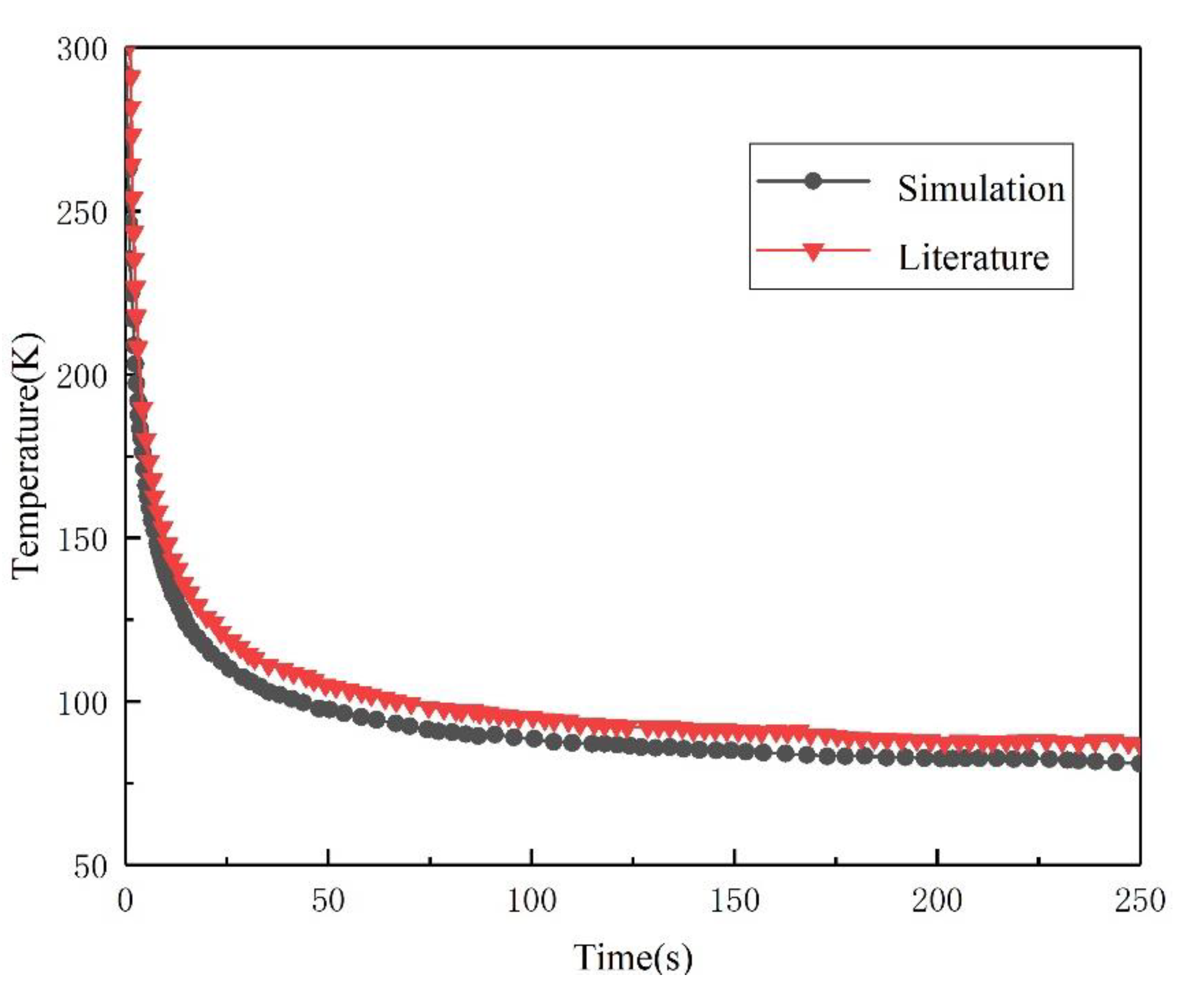
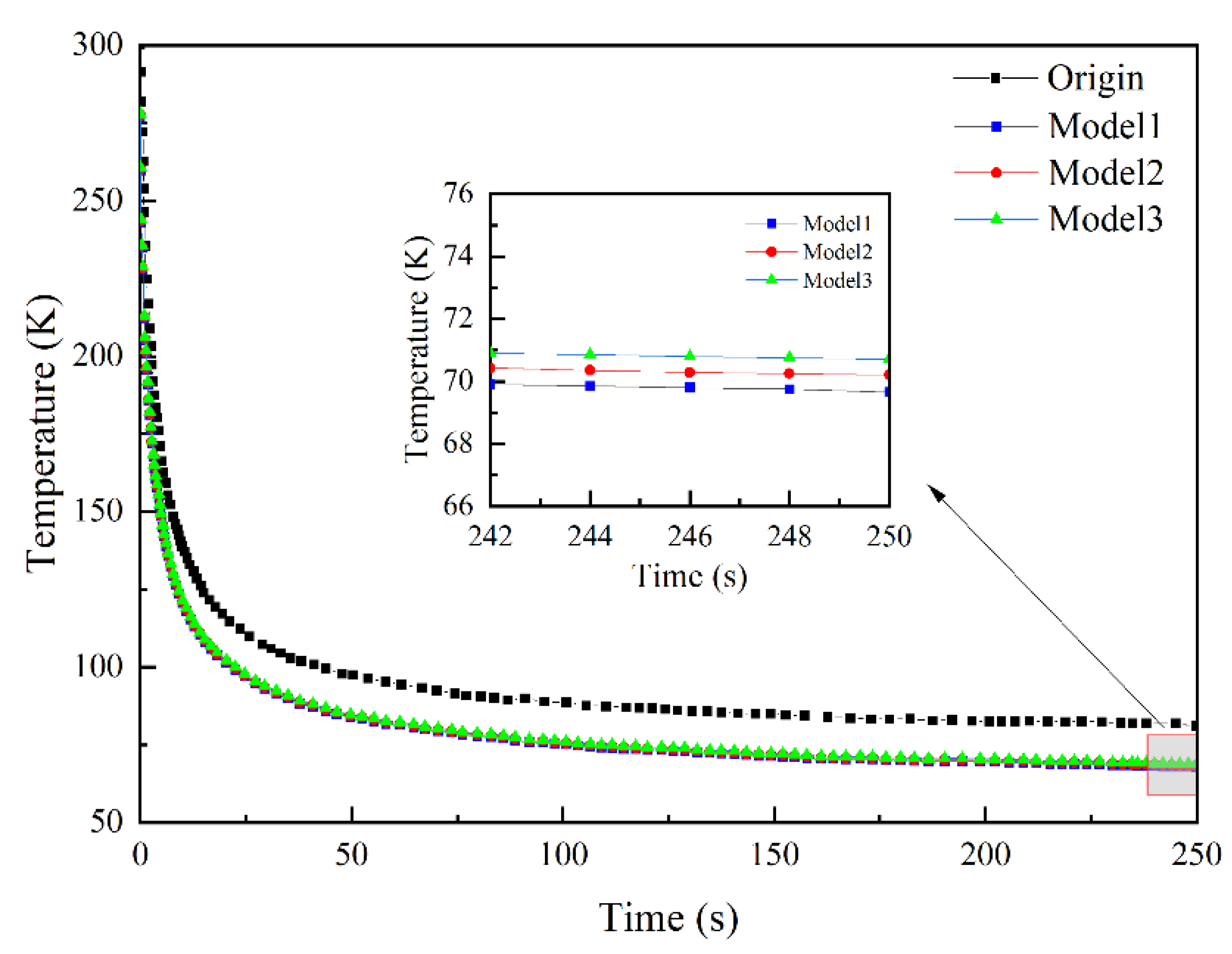
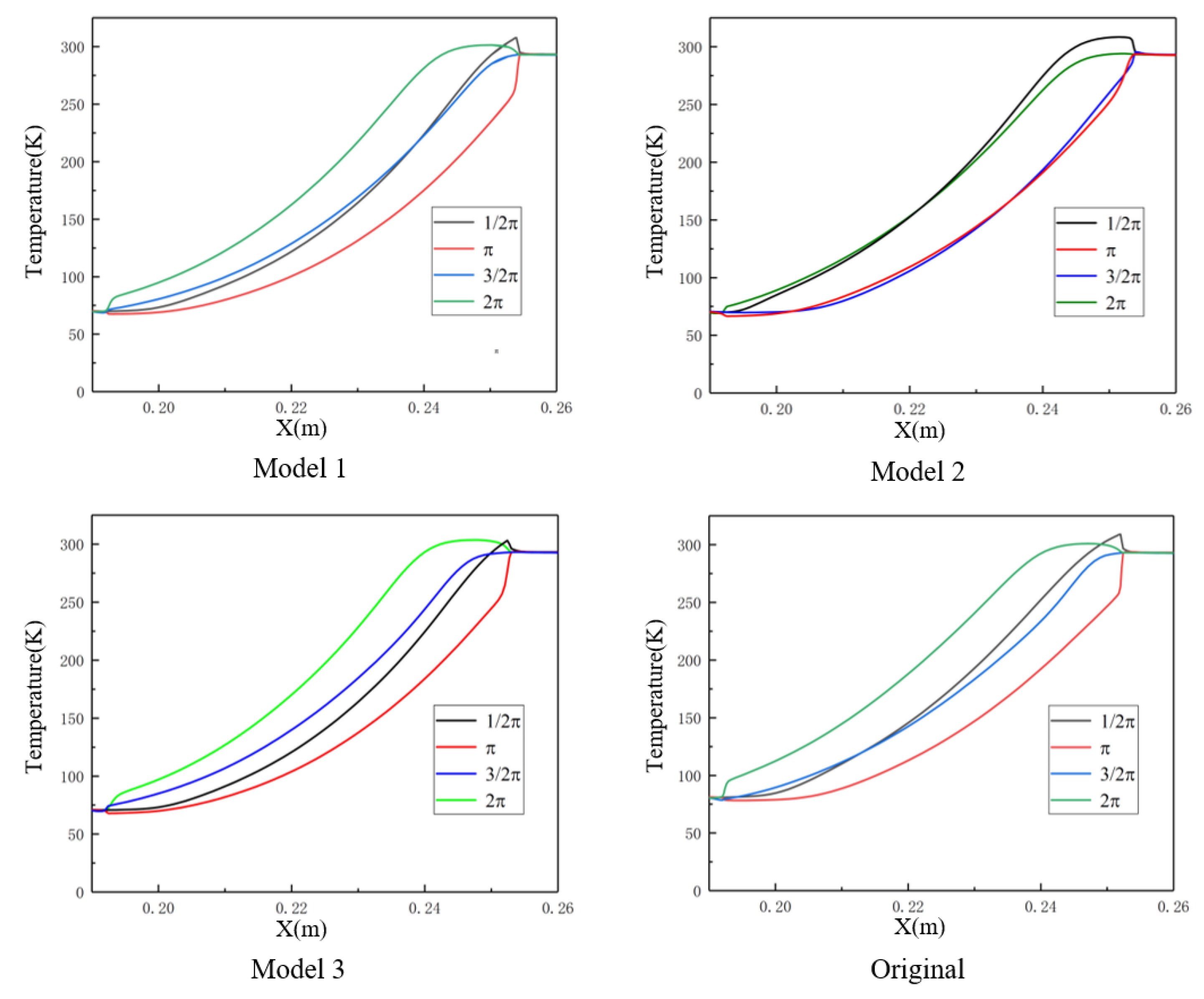
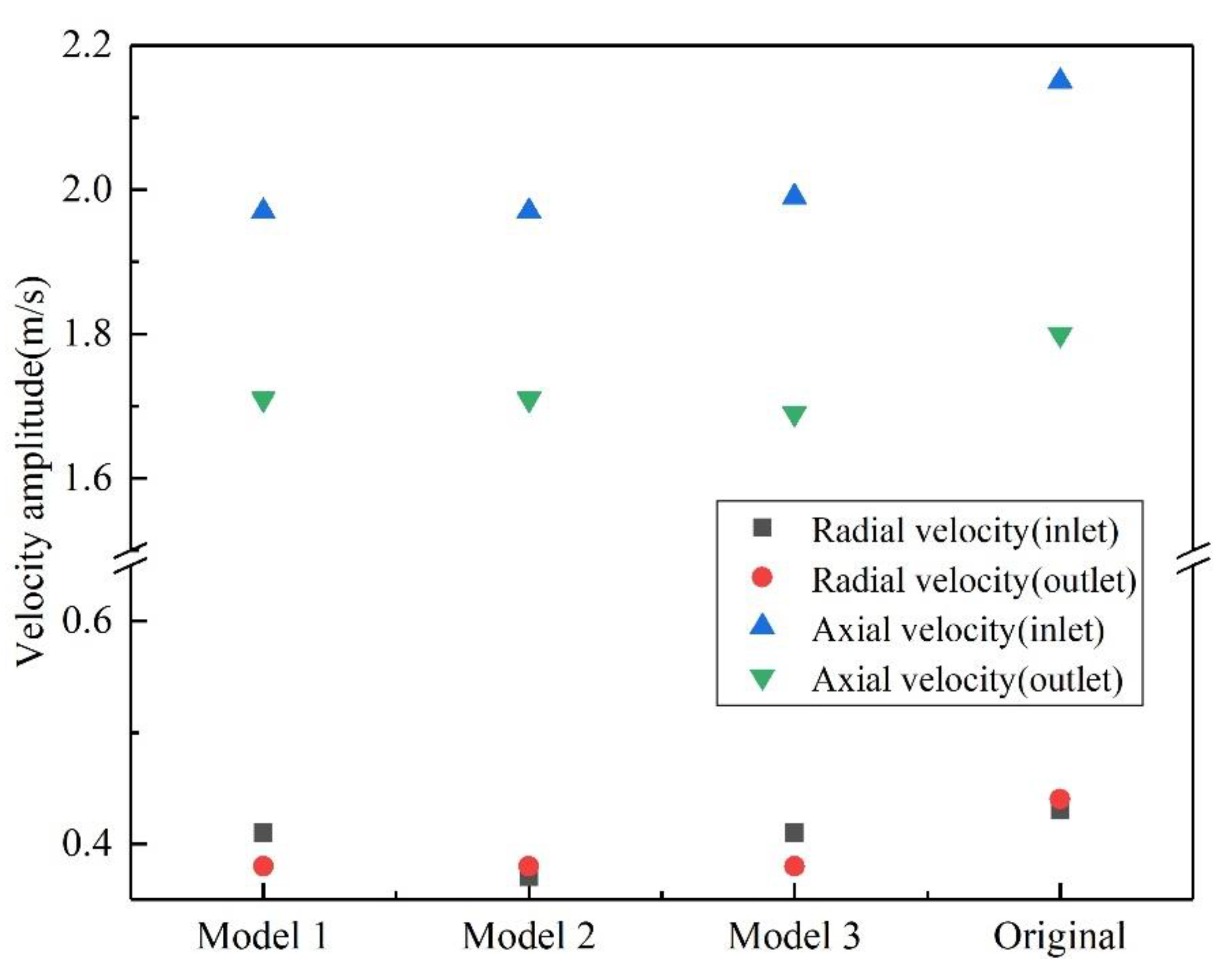



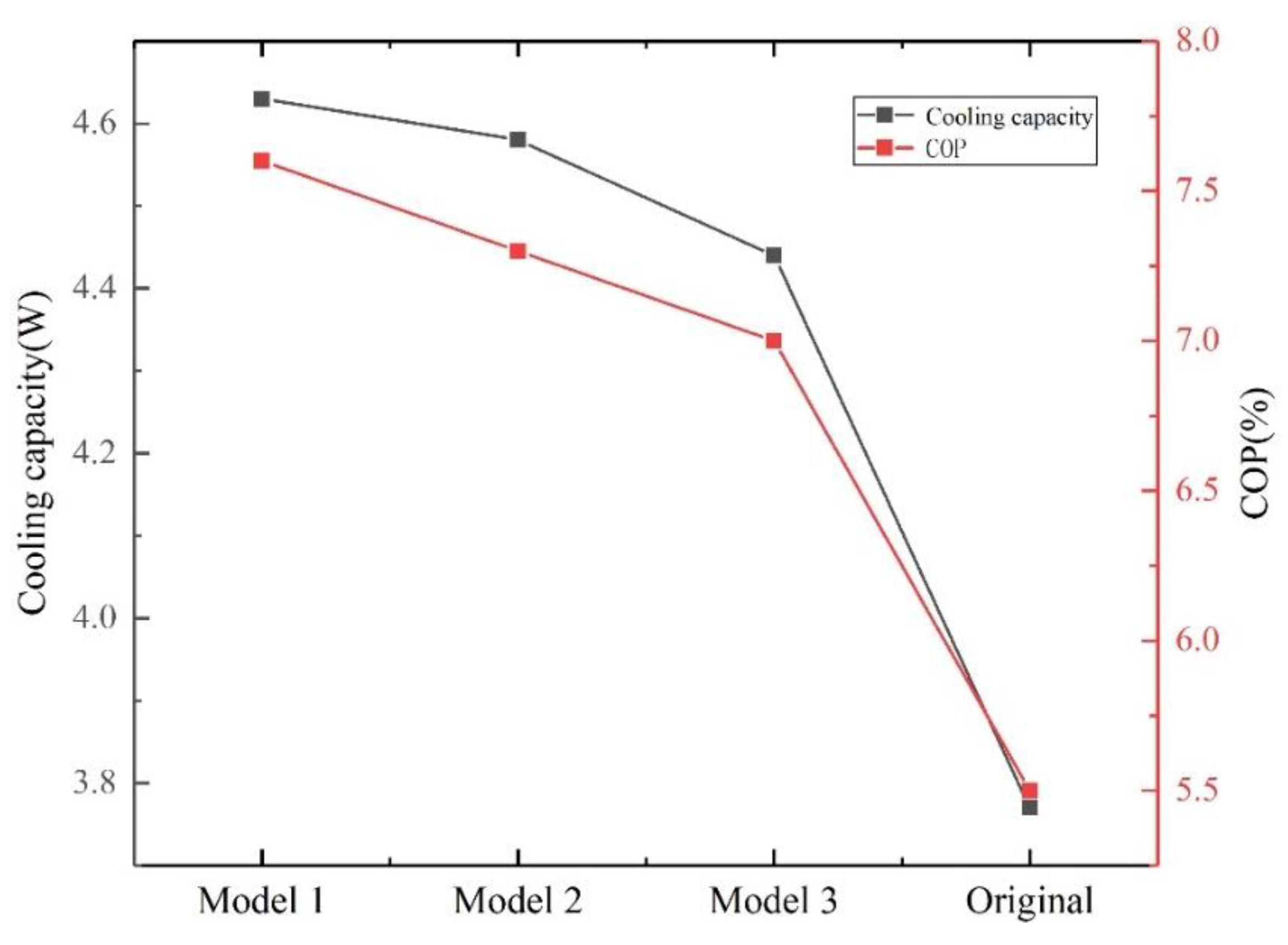
| Components | Number | Radius (mm) | Length (mm) | Material | Boundary Conditions |
|---|---|---|---|---|---|
| Compressor | A | 9.54 | 7.5 | Steel | Adiabatic |
| Transfer line | B | 1.55 | 101 | Steel | Adiabatic |
| WHX1 | C | 4 | 20 | Copper | 300 K |
| Regenerator | D | 4 | 58 | Steel | Adiabatic |
| CHX | E | 3 | 5.7 | Copper | Adiabatic |
| Pulse tube | F | 2.5 | 60 | Steel | Adiabatic |
| WHX2 | G | 4 | 10 | Copper | 300 K |
| Inertance Tube | H | 0.425 | 684 | Steel | Adiabatic |
| gas reservoir | I | 13 | 130 | Steel | Adiabatic |
Disclaimer/Publisher’s Note: The statements, opinions and data contained in all publications are solely those of the individual author(s) and contributor(s) and not of MDPI and/or the editor(s). MDPI and/or the editor(s) disclaim responsibility for any injury to people or property resulting from any ideas, methods, instructions or products referred to in the content. |
© 2023 by the authors. Licensee MDPI, Basel, Switzerland. This article is an open access article distributed under the terms and conditions of the Creative Commons Attribution (CC BY) license (https://creativecommons.org/licenses/by/4.0/).
Share and Cite
Meng, Y.; Cui, Z.; Shao, W.; Ji, W. Numerical Simulation of the Heat Transfer and Flow Characteristics of Pulse Tube Refrigerators. Energies 2023, 16, 1906. https://doi.org/10.3390/en16041906
Meng Y, Cui Z, Shao W, Ji W. Numerical Simulation of the Heat Transfer and Flow Characteristics of Pulse Tube Refrigerators. Energies. 2023; 16(4):1906. https://doi.org/10.3390/en16041906
Chicago/Turabian StyleMeng, Yuan, Zheng Cui, Wei Shao, and Wanxiang Ji. 2023. "Numerical Simulation of the Heat Transfer and Flow Characteristics of Pulse Tube Refrigerators" Energies 16, no. 4: 1906. https://doi.org/10.3390/en16041906








